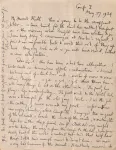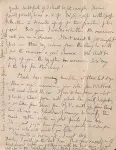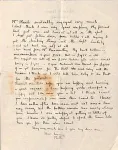(Press-News.org) Letters written by the famous mountaineer George Mallory have been made available to a global audience for the first time, in the centenary year of his fatal attempt to scale Everest.
An alumnus of Magdalene College, Cambridge, Mallory is known for purportedly replying "because it's there" when asked by a reporter why he wanted to climb Everest. There is still debate about whether he and his climbing partner Andrew ‘Sandy’ Irvine did in fact make it to the top of the mountain.
The bulk of the collection is made up of letters written between Mallory and his wife Ruth from the time of their engagement in 1914 until his death on Everest in 1924. Among them are the very last letter he wrote before his final Everest summit attempt and three letters that were retrieved from his body in 1999. These letters survived 75 years in his jacket pocket before his body was discovered.
The letters cover some fascinating topics including:
His first reconnaissance mission to Everest in 1921. There were no existing records or maps, it was uncharted and this was the mission to see if it was even possible to get to the base of Everest.
His second mission to scope out Everest. This mission ended in disaster when eight Sherpas were swept off the mountain and killed in an avalanche. Mallory blamed himself for this tragic accident in his letters.
His service in the First World War including his eyewitness accounts of being in the Artillery during the Battle of the Somme.
Letters from his 1923 visit to the USA in the middle of prohibition, visiting speakeasies, asking for milk and being served whiskey through a secret hatch.
The letters to Mallory from his wife Ruth are a major source of women's social history, covering a wide variety of topics about her life as a woman living through the First World War.
The letters are free to view on the Magdalene College website.
College Archivist Katy Green said: “It has been a real pleasure to work with these letters. Whether it’s George’s wife Ruth writing about how she was posting him plum cakes and a grapefruit to the trenches (he said the grapefruit wasn’t ripe enough), or whether it’s his poignant last letter where he says the chances of scaling Everest are “50 to1 against us”, they offer a fascinating insight into the life of this famous Magdalene alumnus”.
Extracts from the letters include:
From Mallory’s final letter to his wife Ruth before the attempt:
“Darling I wish you the best I can - that your anxiety will be at an end before you get this - with the best news. Which will also be the quickest. It is 50 to 1 against us but we’ll have a whack yet & do ourselves proud. Great love to you. Ever your loving, George.”
From the only surviving letter from the Everest period in the Archive that Ruth Mallory wrote to her husband.
“I am keeping quite cheerful and happy but I do miss you a lot. I think I want your companionship even more than I used to. I know I have rather often been cross and not nice and I am very sorry but the bottom reason has nearly always been because I was unhappy at getting so little of you. I know it is pretty stupid to spoil the times I do have you for those when I don’t.”
From a letter from Mallory's sister Mary Brooke, written from Colombo, Sri Lanka:
“I hope you have been getting the weather reports all right – it will be very interesting to hear whether you can trace a connection with our weather & how long afterwards. Since sending you the observatory report yesterday we have had the most terrific storm… It was most violent for nearly three hours so if you get the same you had better be on the look out…”
ENDS
Notes for Editors
You can access and download the letters here
Interviews with Katy Green available on request.
A limited number of pictures of George Mallory are available on request.
Media contact
Hilary Fletcher, Communications Manager at the University of Cambridge, on Hilary.Fletcher@admin.cam.ac.uk or +44 (0)7720 161808.
About Magdalene College
Magdalene College is a constituent College of the University of Cambridge located in the centre of Cambridge beside the River Cam.
A vibrant, supportive, forward-thinking academic community founded in 1542, there has been a continuous tradition of academic study on the Magdalene site for nearly 600 years.
Magdalene's greatest asset is its people, a resident community of nearly 800 students, Fellows, and staff. The College is home to roughly 350 undergraduates studying all courses offered by the University of Cambridge and 200 postgraduate students. Our small annual intake helps to foster a family atmosphere and a close-knit student community.
The College has roughly 100 Fellows and teaching officers. Our internationally recognised academics and researchers make Magdalene a world-class academic institution and a welcoming research-driven community in which to live and learn.
Home to the world-famous Pepys Library and the Stirling Prize-winning New Library, Magdalene has an eclectic mix of buildings. The Pepys Library, a rare example of a 17th-century private library, was donated to the College 300 years ago by famous diarist and alumni Samuel Pepys, it is regarded as the jewel in the crown of Magdalene.
The New Library won the 2022 Stirling Prize for Architecture for the best new building in the UK. An amazing resource and study space for our students it was funded entirely by donations and is a testament to the support of the Magdalene community. Magdalene alumni are Members of College for life and are very much part of the College community the New Library would not have been possible without the support from alumni around the world.
www.magd.cam.ac.uk
About the University of Cambridge
The University of Cambridge is one of the world’s leading universities, with a rich history of radical thinking dating back to 1209. Its mission is to contribute to society through the pursuit of education, learning and research at the highest international levels of excellence.
Cambridge was second in the influential 2024 QS World University Rankings, the highest rated institution in the UK.
The University comprises 31 autonomous Colleges and over 100 departments, faculties and institutions. Its 24,000 students include around 9,000 international students from 147 countries. In 2023, 73% of its new undergraduate students were from state schools and more than 25% from economically disadvantaged backgrounds.
Cambridge research spans almost every discipline, from science, technology, engineering and medicine through to the arts, humanities and social sciences, with multi-disciplinary teams working to address major global challenges. In the Times Higher Education’s rankings based on the UK Research Excellence Framework, the University was rated as the highest scoring institution covering all the major disciplines.
A 2023 report found that the University contributes nearly £30 billion to the UK economy annually and supports more than 86,000 jobs across the UK, including 52,000 in the East of England. For every £1 the University spends, it creates £11.70 of economic impact, and for every £1 million of publicly-funded research income it receives, it generates £12.65 million in economic impact across the UK.
The University sits at the heart of the ‘Cambridge cluster’, in which more than 5,000 knowledge-intensive firms employ more than 71,000 people and generate £21 billion in turnover. Cambridge has the highest number of patent applications per 100,000 residents in the UK.
www.cam.ac.uk
END
Everest mountaineer’s letters digitized for the first time
2024-04-22
ELSE PRESS RELEASES FROM THIS DATE:
Scientists worldwide in line for US$1.1 million Frontiers Planet Prize as 2024 National Champions announced
2024-04-22
The Frontiers Planet Prize today (22 April) announced 23 National Champions drawn from science research teams across six continents in the second year of the global competition. The Prize recognizes scientists whose research contributes to accelerating solutions that ensure humanity remains safely within the boundaries of the Earth's ecosystem. The National Champions now move forward to the final round of the competition, where three International Champions will be awarded 1 million CHF each to support their research. ...
Study shows more than half of global infectious diseases experts surveyed rate influenza as the number one pathogen of concern of pandemic potential
2024-04-21
**Note: this is an early release from the ESCMID Global Congress (formerly ECCMID, Barcelona, Spain, 27-30 April). Please credit the congress if you use this story**
New research presented at the ESCMID Global Congress (formerly ECCMID) in Barcelona, Spain (27-30 April) shows that in a VACCELERATE Consortium survey study in which infectious diseases experts were asked to rank pathogens in order of their pandemic potential, influenza was considered the pathogen of highest pandemic risk, with 57% ranking influenza as number one, and a further 17% ranking it second (See full table, notes to editors).
The study is by Dr Jon Salmanton-García, University ...
Empty-handed neurons might cause neurodegenerative diseases
2024-04-20
Tokyo, Japan – Researchers from Tokyo Metropolitan University have identified how proteins collect abnormally in neurons, a feature of neurodegenerative diseases like Alzheimer’s. They used fruit flies to show that depletion of mitochondria in axons can directly lead to protein accumulation. At the same time, significantly high amounts of a protein called eIF2β were found. Restoring the levels to normal led to a recovery in protein recycling. Such findings promise new treatments for neurodegenerative diseases.
Every cell in our bodies is a busy factory, where proteins ...
Black women hospitalised in USA with blood infection resistant to last-resort antibiotic at increased risk of death
2024-04-20
Nationwide analysis of a large, geographically diverse cohort of adults in the USA suggests increased risk for hospital-acquired carbapenem-resistant enterobacterales bloodstream infections among racial and ethnic minorities may be due in part to hospitalisations for underlying comorbidities and associated with racial and biological sex inequities
**ECCMID has now changed name to ESCMID Global, please credit ESCMID Global Congress (Barcelona, Spain, 27-30 April) in all future stories**
New research being presented at this year’s ESCIMD Global Congress (formerly ...
NEC Society Statement on the Watson vs. Mead Johnson Verdict
2024-04-19
Given the litigation involving products used to feed and support the growth of preterm infants and the direct implication for infants who are at risk of and who have been affected by necrotizing enterocolitis (NEC), the NEC Society previously released a statement on the lawsuits. This statement addresses the Watson case.
Necrotizing enterocolitis is a devastating intestinal inflammatory disease that can affect premature or otherwise medically fragile infants during their first weeks and months of life. Upon diagnosis, many babies have only hours or days before their intestines become necrotic, progressing to sepsis, multisystem ...
Lemur’s lament: When one vulnerable species stalks another
2024-04-19
What can be done when one threatened animal kills another? Scientists studying critically endangered lemurs in Madagascar confronted this difficult reality when they witnessed attacks on lemurs by another vulnerable species, a carnivore called a fosa.
This dynamic can be particularly complex when the predation occurs in an isolated or poor-quality habitat, according to research from Washington University in St. Louis and the University of Antananarivo in Madagascar.
In the new paper published in Ecology and Evolution, researchers describe how they were observing small groups of critically endangered diademed ...
Surf clams off the coast of Virginia reappear – and rebound
2024-04-19
The Atlantic surfclam, an economically valuable species that is the main ingredient in clam chowder and fried clam strips, has returned to Virginia waters in a big way, reversing a die-off that started more than two decades ago.
In a comprehensive study of surfclams collected from an area about 45 miles due east from the mouth of the Chesapeake Bay, Rutgers scientists found the population to be thriving and growing. A likely reason could be that environmental conditions improved, and another possibility is that the clams adapted, ...
Studying optimization for neuromorphic imaging and digital twins
2024-04-19
Harbir Antil (PI), director of the Center for Mathematics and Artificial Intelligence (CMAI), professor of Mathematical Sciences, and Rainald Löhner (co-PI), director of Computational Fluid Dynamics Lab, professor of Physics and Astronomy, received funding from the Air Force Office of Scientific Research (AFOSR), under the prestigious DURIP program, to establish a neuromorphic imaging and digital twins lab with capabilities to design new optimization algorithms.
This project will set up the Neuromorphic Imaging and Digital Twins Lab—a first of its kind ...
ORNL researchers win Best Paper award for nickel-based alloy tailoring
2024-04-19
Rishi Pillai and his research team from the Department of Energy’s Oak Ridge National Laboratory will receive a Best Paper award from the American Society of Mechanical Engineers International Gas Turbine Institute in June at the Turbo Expo 2024 in London.
The winning paper is “Leveraging Additive Manufacturing to Fabricate High Temperature Alloys with Co-Designed Mechanical Properties and Environmental Resistance,” which Pillai presented in June at the Turbo Expo 2023 in Boston.
The ORNL scientists co-designed a compositionally graded nickel-based alloy for molten halide salts-supercritical carbon dioxide heat exchangers. The objective ...
New beta-decay measurements in mirror nuclei pin down the weak nuclear force
2024-04-19
The Science
The Standard Model of Particle Physics is scientists’ best understanding of the forces that describe how subatomic particles interact. The Standard Model encompasses four forces: the strong nuclear force, the weak nuclear force, the electromagnetic force, and the gravitational force. All four forces govern the way our universe works. However, the weak nuclear force is exceptionally difficult to study as it is overshadowed by the much greater effects of the strong nuclear and electromagnetic forces. Scientists have gained new ...









